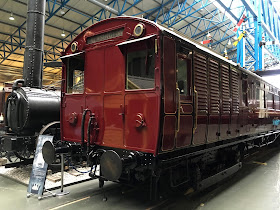 |
| Two views of 28249 now preserved at the NRM York |
As well as different traction equipment, the Oerlikon sets had other differences compared to the Siemens sets. Originally the EMUs had first and third class accommodation, the first class compartments being very luxurious, but were downgraded to third class only as a wartime economy measure. The EMUs were built as 3-car sets (with some spare motor cars) and generally operated as a 6-car train.
| Information | |
|---|---|
| Number built: | 356 (117 3-car sets + 8 spare cars) |
| Built: | 1914-23 |
| Builder: | Metropolitan-Cammell |
| Engine: | 4 Siemens or Oerlikon traction motors (630v DC third/fourth rail) |
| Power: | (Siemens) 1, 000 hp (746 kW) (Oerlikon) 1, 040 hp (776 kW) |
| Formation: | Driving Motor Brake Third (DMBT)+Trailer Third (TT)+ Driving Trailer Third (DTT) |
After the First World War a third batch of 75 sets were built, again with Oerlikon equipment [2]. Although some of the DC routes (some of which now are part of London Overground) were run down in the 1930s and following the Second World War, the LNWR sets (later operated by the LMS and British Railways) survived in use until 1960. Some sets were converted to prototype 25kv AC OHLE EMUs as AM1. One DMBT has survived into preservation.
 |
| 28249 is preserved in LMS livery |
[1] R.L. Vickers, DC Electric Trains and Locomotives in the British Isles (David & Charles, 1986) p. 69
[2] Colin J. Marsden, DMU and EMU Recognition Guide (Ian Allan, 2013) p. 186
